DKT Test ( Intersection) #1
What should you do if you arrive to a crossroads and the road ahead is clogged with vehicles traveling in the same direction?
Explanation:
If you are unable to cross the crossroads, you risk causing traffic congestion in the opposite direction.
When you see a GIVE WAY sign at a junction, it implies you must:
Explanation:
Give way signs are placed at crossings where visibility is good enough to gauge approaching traffic, as opposed to stopping signs, which are placed at intersections with poor visibility. You must, however, be prepared to come to a stop.
Is it necessary to give way to vehicles arriving from both the left and right when turning right at a T-intersection?
Explanation:
All vehicles on the route you're turning onto must yield to you.
When police officers are offering directions at crosswalks, you must:
Explanation:
At intersections, police officers' signals take precedence over any signs or lights.
In Sydney, you come to an intersection where a Light Rail vehicle is going to enter. So, what are your options?
Explanation:
You'll have to wait until the junction is clear before proceeding.
Is the line drawn across the road meaningful if a STOP or GIVE WAY sign has been knocked down, for example, as a result of an accident?
Explanation:
The line's meaning is the same as the sign's.
When approaching a railway level crossing with a STOP sign, what should you do?
Explanation:
At a stop sign, you must always come to a complete stop.
Advertisement
Are you required to give way to pedestrians when turning at an intersection?
Explanation:
If a collision is imminent, pedestrians have the right of way.
Even if the signal at a railway level crossing does not indicate that a train is approaching, you should nevertheless take the following precautions:
Explanation:
In these instances, always be prepared to stop in case you haven't spotted the train approaching.
Both of the cars O and P in this diagram must proceed past GIVE WAY signs before reaching the intersection. Which car will start out first?
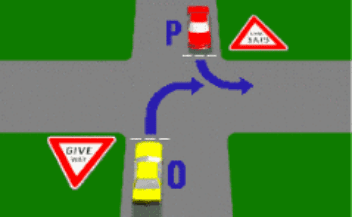
Explanation:
The right of way belongs to vehicle P.
You are driving car A through the intersection straight ahead. Who should yield the right-of-way?
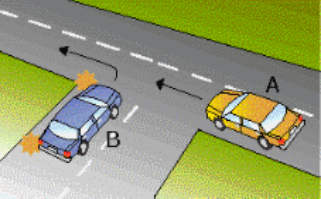
Explanation:
You have the right of way over cars approaching from the left.
When these lights flash, it indicates

Explanation:
Until the next green signal, pedestrians must wait to cross.
The arrow-designated street is where the red car wants to make a right turn and leave the circle. Is the car in the correct lane to do this?
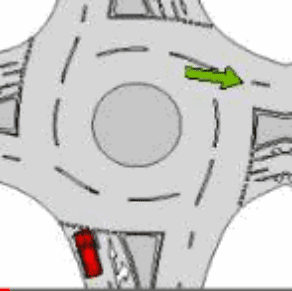
You are in the right-hand lane and intend to pass through the roundabout directly. When should you give the left turn signal to leave the roundabout?
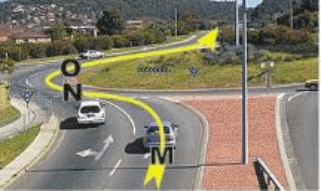
Explanation:
At point O, you must give a signal. Always give the go-ahead to leave the roundabout after the exit before the one you are taking. If you are travelling straight over a roundabout, signal left to signify your exit rather than right.
Advertisement
Is it possible for the marked car to turn right at this two-lane roundabout?
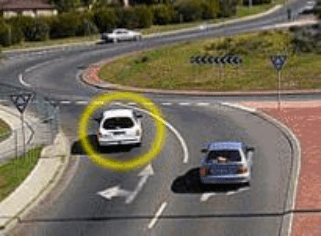
Explanation:
The car is in a lane that is only for left turns or straightaways.
Which car in the illustration needs to yield?
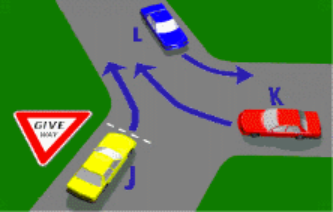
Explanation:
Vehicle J must make way.
The rider of the motorcycle wants to proceed straight through this roundabout. The marked car should be avoided by the rider since it:
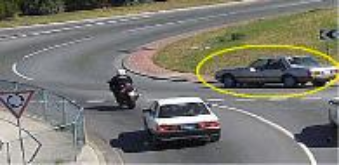
Explanation:
The motorbike will be in the path of the car when it exits the roundabout.
When traveling on a laned roadway, right turns must be made from which lanes?
Explanation:
Only lanes on the right or those with an arrow pointing to the right may be used to make right turns.
A designated pedestrian crossing is seen in the diagram at an intersection. At the intersection, there is a STOP sign as well. For a pedestrian, you have already stopped. Do you have to stop at the STOP line again?
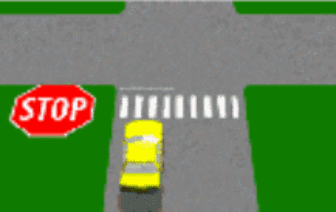
Explanation:
At a stop sign, you must always stop.
Should you give way to vehicles arriving from both the left and right when turning right at a T-intersection (as shown)?
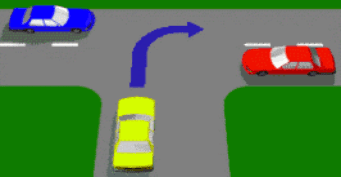
Explanation:
You must give way to all vehicles on the route you are turning onto.